Choosing a Gaming CPU: Single + Multi-GPU at 1440p, April 2013
by Ian Cutress on May 8, 2013 10:00 AM ESTCPU Benchmarks
Point Calculations - 3D Movement Algorithm Test
The algorithms in 3DPM employ both uniform random number generation or normal distribution random number generation, and vary in amounts of trigonometric operations, conditional statements, generation and rejection, fused operations, etc. The benchmark runs through six algorithms for a specified number of particles and steps, and calculates the speed of each algorithm, then sums them all for a final score. This is an example of a real world situation that a computational scientist may find themselves in, rather than a pure synthetic benchmark. The benchmark is also parallel between particles simulated, and we test the single threaded performance as well as the multi-threaded performance.
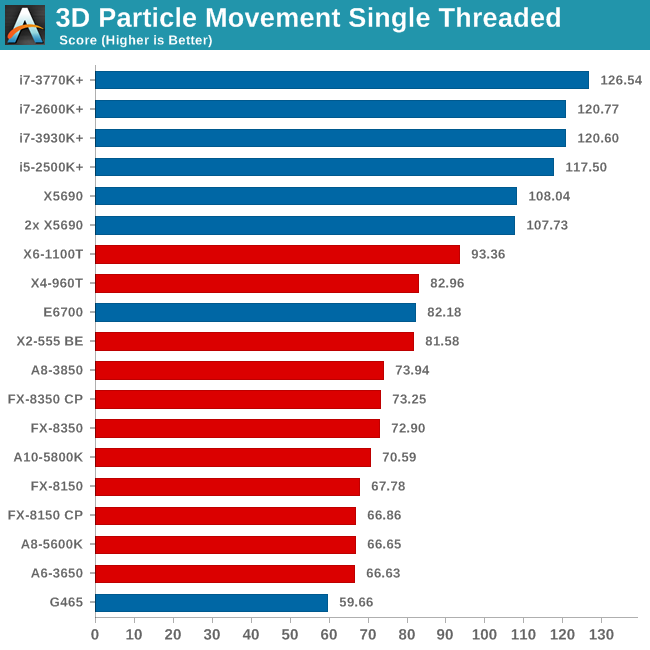
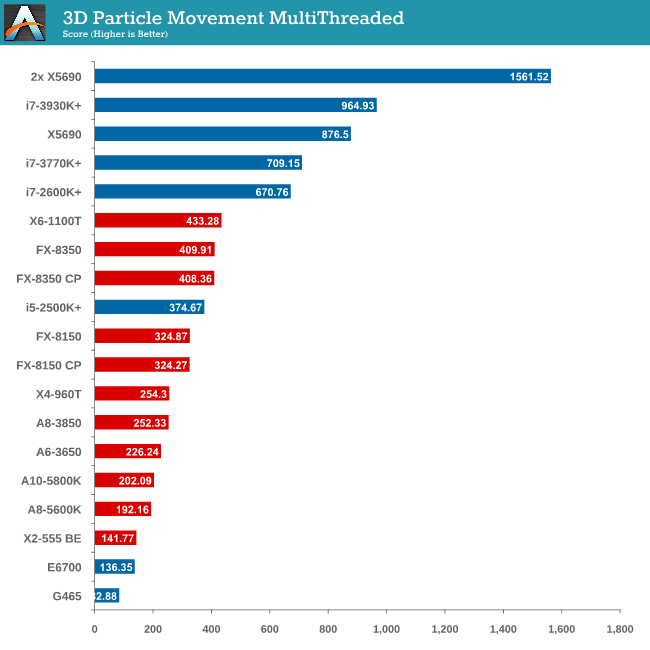
As mentioned in previous reviews, this benchmark is written how most people would tackle the situation – using floating point numbers. This is also where Intel excels, compared to AMD’s decision to move more towards INT ops (such as hashing), which is typically linked to optimized code or normal OS behavior.
Compression - WinRAR x64 3.93 + WinRAR 4.2
With 64-bit WinRAR, we compress the set of files used in our motherboard USB speed tests. WinRAR x64 3.93 attempts to use multithreading when possible and provides a good test for when a system has variable threaded load. WinRAR 4.2 does this a lot better! If a system has multiple speeds to invoke at different loading, the switching between those speeds will determine how well the system will do.
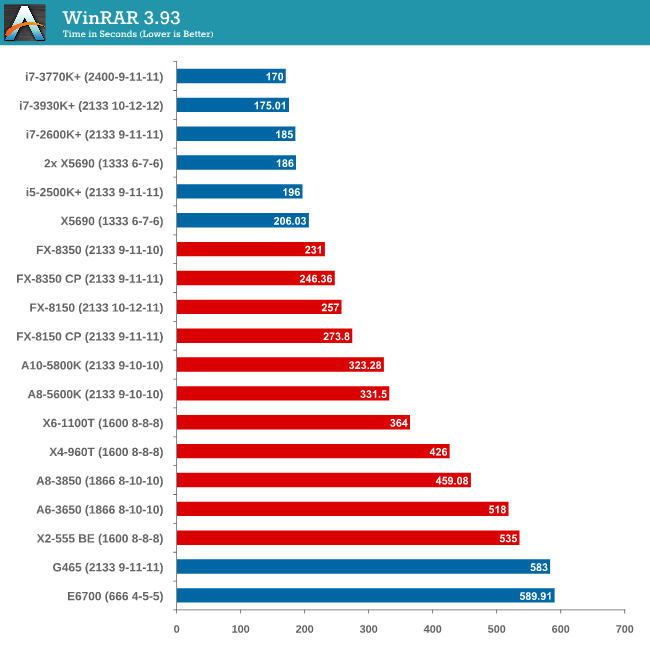

Due to the late inclusion of 4.2, our results list for it is a little smaller than I would have hoped. But it is interesting to note that with the Core Parking updates, an FX-8350 overtakes an i5-2500K with MCT.
Image Manipulation - FastStone Image Viewer 4.2
FastStone Image Viewer is a free piece of software I have been using for quite a few years now. It allows quick viewing of flat images, as well as resizing, changing color depth, adding simple text or simple filters. It also has a bulk image conversion tool, which we use here. The software currently operates only in single-thread mode, which should change in later versions of the software. For this test, we convert a series of 170 files, of various resolutions, dimensions and types (of a total size of 163MB), all to the .gif format of 640x480 dimensions.
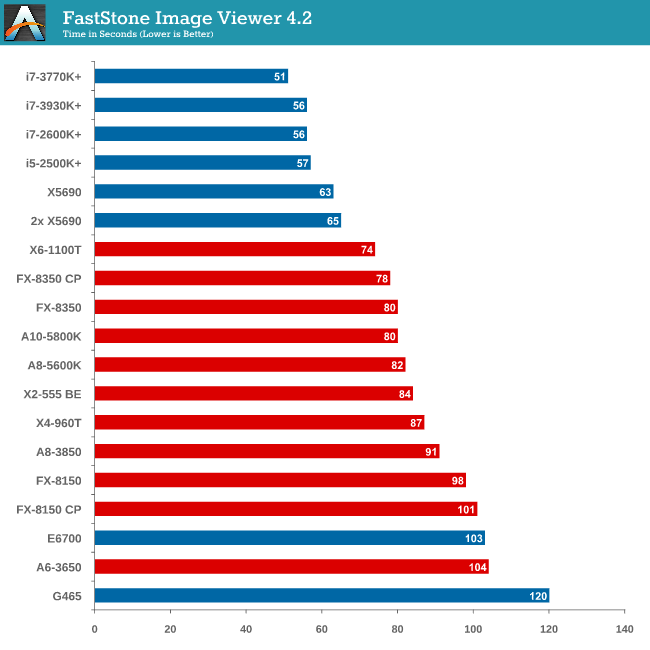
In terms of pure single thread speed, it is worth noting the X6-1100T is leading the AMD pack.
Video Conversion - Xilisoft Video Converter 7
With XVC, users can convert any type of normal video to any compatible format for smartphones, tablets and other devices. By default, it uses all available threads on the system, and in the presence of appropriate graphics cards, can utilize CUDA for NVIDIA GPUs as well as AMD WinAPP for AMD GPUs. For this test, we use a set of 33 HD videos, each lasting 30 seconds, and convert them from 1080p to an iPod H.264 video format using just the CPU. The time taken to convert these videos gives us our result.
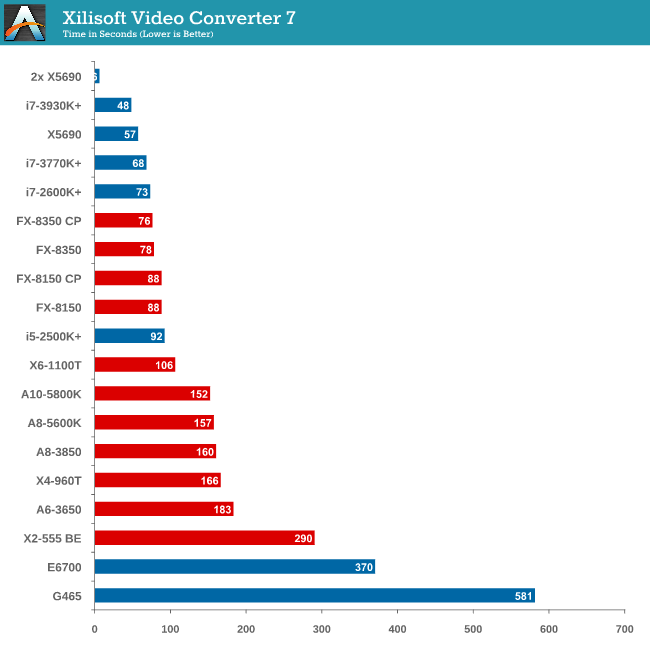
XVC is a little odd in how it arranges its multicore processing. For our set of 33 videos, it will arrange them in batches of threads – so if we take the 8 thread FX-8350, it will arrange the videos into 4 batches of 8, and then a fifth batch of one. That final batch will only have one thread assigned to it (!), and will not get a full 8 threads worth of power. This is also why the 2x X5690 finishes in 6 seconds but the normal X5690 takes longer – you would expect a halving of time moving to two CPUs but XVC arranges the batches such that there is always one at the end that only gets a single thread.
Rendering – PovRay 3.7
The Persistence of Vision RayTracer, or PovRay, is a freeware package for as the name suggests, ray tracing. It is a pure renderer, rather than modeling software, but the latest beta version contains a handy benchmark for stressing all processing threads on a platform. We have been using this test in motherboard reviews to test memory stability at various CPU speeds to good effect – if it passes the test, the IMC in the CPU is stable for a given CPU speed. As a CPU test, it runs for approximately 2-3 minutes on high end platforms.
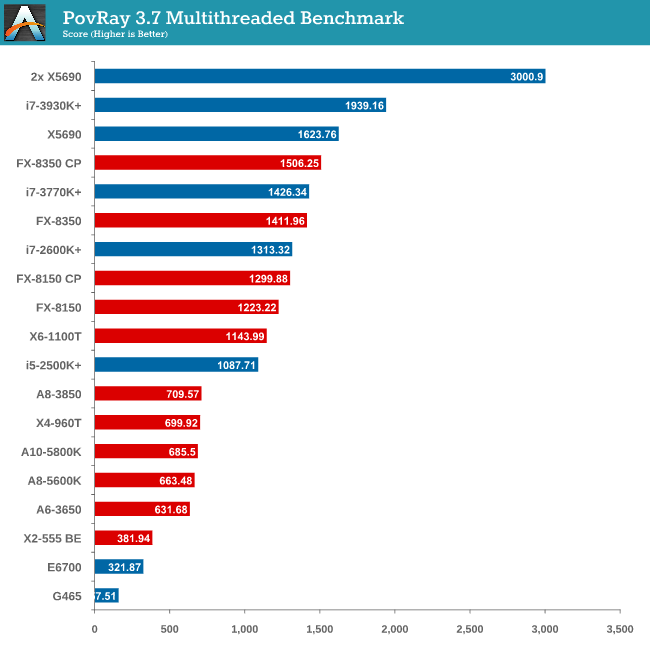
The SMP engine in PovRay is not perfect, though scaling up in CPUs gives almost a 2x effect. The results from this test are great – here we see an FX-8350 CPU below an i7-3770K (with MCT), until the Core Parking updates are applied, meaning the FX-8350 performs better!
Video Conversion - x264 HD Benchmark
The x264 HD Benchmark uses a common HD encoding tool to process an HD MPEG2 source at 1280x720 at 3963 Kbps. This test represents a standardized result which can be compared across other reviews, and is dependent on both CPU power and memory speed. The benchmark performs a 2-pass encode, and the results shown are the average of each pass performed four times.
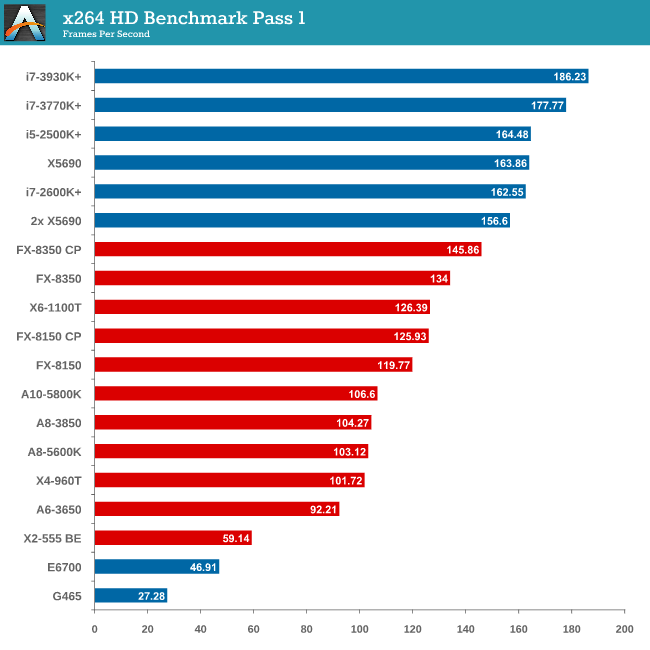
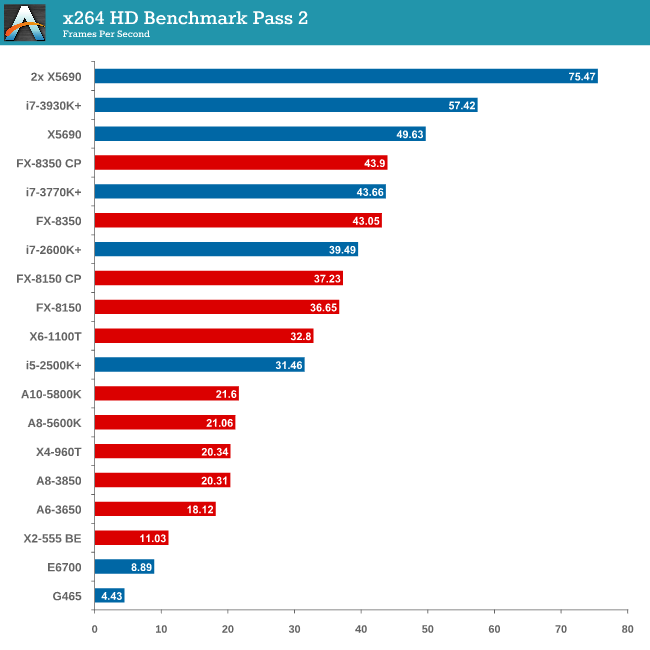
Grid Solvers - Explicit Finite Difference
For any grid of regular nodes, the simplest way to calculate the next time step is to use the values of those around it. This makes for easy mathematics and parallel simulation, as each node calculated is only dependent on the previous time step, not the nodes around it on the current calculated time step. By choosing a regular grid, we reduce the levels of memory access required for irregular grids. We test both 2D and 3D explicit finite difference simulations with 2n nodes in each dimension, using OpenMP as the threading operator in single precision. The grid is isotropic and the boundary conditions are sinks. Values are floating point, with memory cache sizes and speeds playing a part in the overall score.
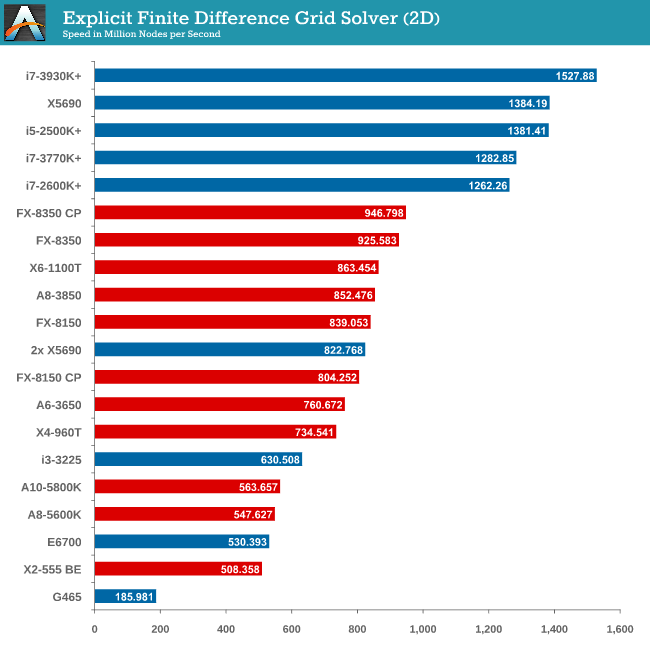
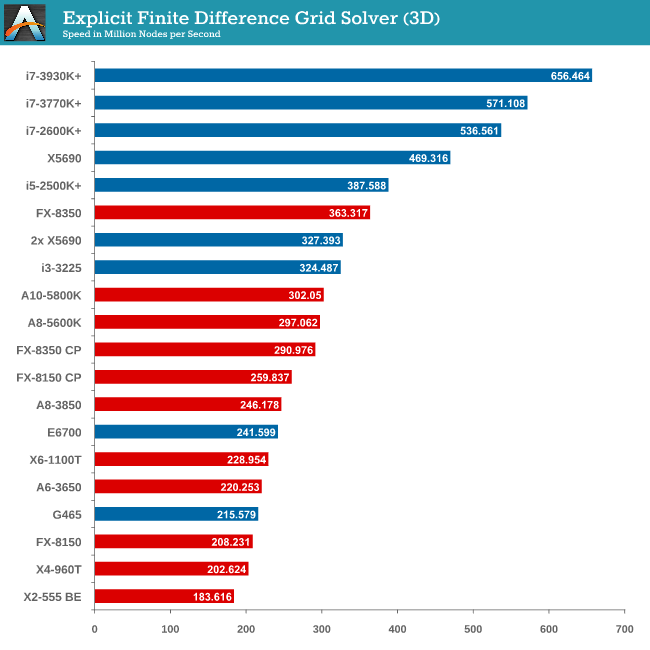
Grid solvers do love a fast processor and plenty of cache in order to store data. When moving up to 3D, it is harder to keep that data within the CPU and spending extra time coding in batches can help throughput. Our simulation takes a very naïve approach in code, using simple operations.
Grid Solvers - Implicit Finite Difference + Alternating Direction Implicit Method
The implicit method takes a different approach to the explicit method – instead of considering one unknown in the new time step to be calculated from known elements in the previous time step, we consider that an old point can influence several new points by way of simultaneous equations. This adds to the complexity of the simulation – the grid of nodes is solved as a series of rows and columns rather than points, reducing the parallel nature of the simulation by a dimension and drastically increasing the memory requirements of each thread. The upside, as noted above, is the less stringent stability rules related to time steps and grid spacing. For this we simulate a 2D grid of 2n nodes in each dimension, using OpenMP in single precision. Again our grid is isotropic with the boundaries acting as sinks. Values are floating point, with memory cache sizes and speeds playing a part in the overall score.
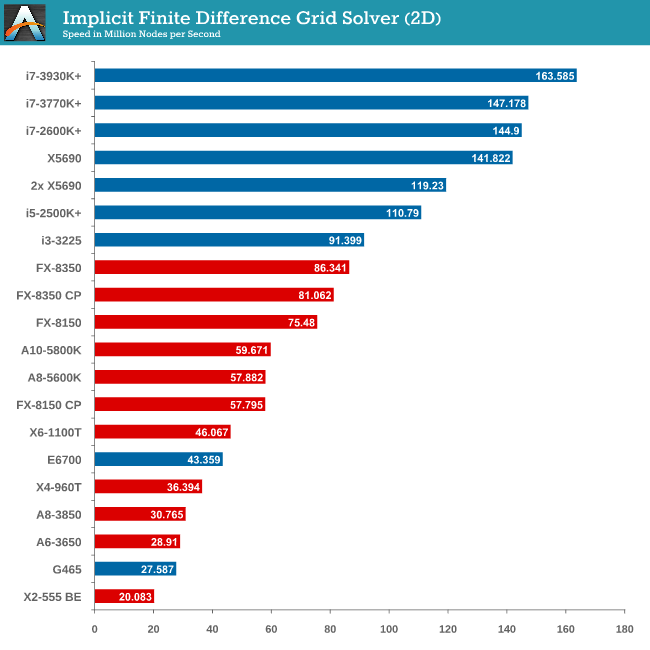
2D Implicit is harsher than an Explicit calculation – each thread needs more a lot memory, which only ever grows as the size of the simulation increases.
Point Calculations - n-Body Simulation
When a series of heavy mass elements are in space, they interact with each other through the force of gravity. Thus when a star cluster forms, the interaction of every large mass with every other large mass defines the speed at which these elements approach each other. When dealing with millions and billions of stars on such a large scale, the movement of each of these stars can be simulated through the physical theorems that describe the interactions. The benchmark detects whether the processor is SSE2 or SSE4 capable, and implements the relative code. We run a simulation of 10240 particles of equal mass - the output for this code is in terms of GFLOPs, and the result recorded was the peak GFLOPs value.
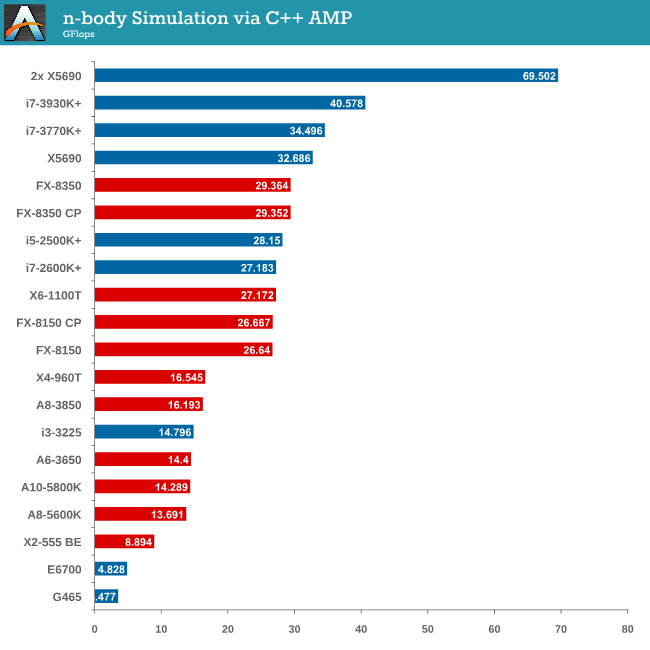
As we only look at base/SSE2/SSE4 depending on the processor (auto-detection), we don’t see full AVX numbers in terms of FLOPs.










242 Comments
View All Comments
Spunjji - Wednesday, May 8, 2013 - link
Crap troll is crap.lorribot - Wednesday, May 8, 2013 - link
Would love to see something like a E3-1230 tested, it is around the same price as a i5-3570K but has no graphics, bigger cache and Hyper threading, but no over clocking and 100MHz lower clock. should be similar to a i7-3770 for around 60% of the price.Spunjji - Wednesday, May 8, 2013 - link
So let me get this straight. The engineers are idiots, yet you want them to go and work for other companies, the best candidate there being Intel. Also, thanks to this apparent mental handicap, they use Intel processors... oh, I get it, you're pro AMD!bikerbass77 - Wednesday, May 8, 2013 - link
Just a note as I keep seeing posts going on about Planetside 2 being CPU limited. It is not. I am saying this from experience having played it just fine on a Core2Duo based system. The reason you are most likely having problems will either be your ping or your GPU. I was running with a GTX 460 1gb card and it was fine for that particular game. I have just upgraded to a new CPU because the main game I play (Mechwarrior Online) is far more CPU bound being based on CryEngine 3.cusideabelincoln - Wednesday, May 8, 2013 - link
I think it should be noted that online multiplayer games are a different beast. Multiplayer is typically more CPU intensive, and if you're looking to maintain completely smooth gameplay without any dips in framerate or stuttering then the CPU becomes more important than it is for single player gaming.Also would you consider benchmarking live, online streaming of games? Would be great to see how much of a benefit the 3930K would have over other chips, and if Piledriver can pull ahead of the i5s definitively.
Markus_Antonius - Wednesday, May 8, 2013 - link
Your sample size is statistically beyond irrelevant which prevents the scientist in me from drawing any conclusions from it. In addition, claiming any sort of causal relationship between results is outright scientifically wrong even if the sample size would be statistically relevant. From an engineering standpoint the X79 systems with ample headroom in every relevant department would be the best choice to avoid any possible bottlenecks / contention issues in the largest possible number of different workloads.Any recent system with a recent CPU and recent midrange graphics card can play a game and can often play it well. Advising a Core i7 3770K based on a statistically irrelevant benchmark while disregarding systems architecture is something that neither the scientist, the software engineer and the hobbyist in me can get behind in any way.
JarredWalton - Wednesday, May 8, 2013 - link
Hyperbole, you have a new friend: meet Markus! "Beyond irrelevant", "any conclusions", "outright scientifically wrong", "ample headroom", "every relevant department", "best choice"....Let me guess: you have an X79 system, and it works great for you, and thus anyone even suggesting that it might not be the best thing since sliced bread is something you can't even think about in any way. This article is focused on gaming, and if you want to do things besides gaming yes, you will need to consider other facets of the system build. At the same time, if all you're looking for is a good gaming setup, perhaps with two or three GPUs, I have trouble imagining anyone recommending something other than i7-3770K right now (unless the recommendation is to "wait for Haswell").
Let me give you a few things to consider that, while the scientist may not necessarily agree, the software engineer and hobbyist definitely would avoid SNB-E and workstations. 1) Overall power requirements (they still matter). 2) Quick Sync (may not be perfect quality, but dang it's fast). 3) Better performance in many games with two GPUs, no matter what paper specs and system architectures might say.
smuff3758 - Thursday, May 9, 2013 - link
And that, Jared, is how to shut down this arrogant, condescending self-titled expert/scientist. I guess he must think the rest of us are bozos who come here for the comic relief?Markus_Antonius - Sunday, May 12, 2013 - link
My comment was about the testing method not being scientifically sound even though the author makes it a point to refer to the "well-adjusted scientist" in himself. There's a huge number of games out there as well as a lot of different mid-range to high-end video cards. Recommending an i7 3770K on the basis of one resolution tested and only 4 games is something that you absolutely cannot call science.I am among other responsibilities a software engineer and I don't actively avoid Sandy Bridge E and workstations.
My criticism of the methods used and the conclusions drawn is valid criticism, especially in the face of the article being given the appearance of being science.
If you're going to do recommendations based on statistics and for whatever reason decide to disregard engineering and the science behind systems design you're going to need a far larger sample size than what was used here.
You can deflect this all you want by quoting power usage and quicksync but while power usage power usage should be a factor, this test was not about quicksync. If it had been they would not have tested X79 systems at all ;-)
From both work and hobby I know a lot of power users and gaming remains one of the most demanding uses and one of the *most prevalent* demanding uses of a modern PC. Throwing a more powerful system aside and disregarding engineering needs to be done with a lot more care and thoroughness, all of which is missing here.
Answering valid criticism with scorn and aggression is also very telling. Perhaps you're more insecure than you thought you were?
Badelhas - Wednesday, May 8, 2013 - link
Great review, congrats!This comes at a perfect time for me, I just ordered a Qnix QX2710 1440p 27 inch monitor from ebay and a couple of 670´s to work along with my 2500k OCed to 4.5Ghz. It seems I will be amazed with that upgrade, lets see!
Cheers